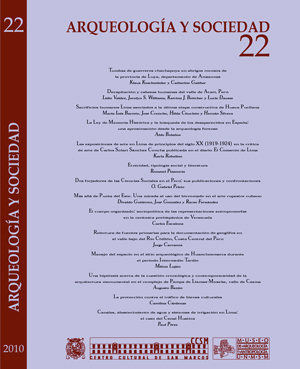THE ORGANIZED BODY: SOCIO-POLITICAL OF ANTHROPOMORPHOUS REPRESENTATION IN VENEZUELAN PREHISPANIC CERAMICS
DOI:
https://doi.org/10.15381/arqueolsoc.2010n22.e12296Keywords:
Human figuration, barrancoid-saladoid series, valencioid, Betijoque-Mirinday styles.Abstract
In Venezuela there has been little systematic research has focused entirely on the pre-Columbian pottery human figuration. They have worked on a regional problem limited to the Valencioid interaction sphere and the Andean area. Accordingly, by this work, using as a frame of reference the anthropomorphic figurative pieces egalitarian tribal societies Barrancoid-Saladoid in the Orinoco and tribal cultures and hierarchical cacicales Valencioid Mirinday Betijoque-central coast and in the Venezuelan Andes, respectively. We considered an inquiry by way of comparison between different periods, regions and / or culture from body theory in archeology. Through formal deconstruction of parts for the definition of figurative patterns, dare we say anthropomorphic ceramic pieces were probably powerful vehicles used by the company to spread personal and communal identities and reveal socially accepted power relations between the individuals and their environment.Downloads
Published
Issue
Section
License
Copyright (c) 2010 Carlos Escalona Villalonga

This work is licensed under a Creative Commons Attribution-NonCommercial-ShareAlike 4.0 International License.
THE AUTHORS RETAIN THEIR RIGHTS:
a. The authors retain their trademark and patent rights, and also on any process or procedure described in the article.
b. The authors retain the right to share, copy, distribute, perform and publicly communicate the article published in the Arqueología y Sociedad (for example, place it in an institutional repository or publish it in a book), with an acknowledgment of its initial publication in the Arqueología y Sociedad.
c. The authors retain the right to make a subsequent publication of their work, to use the article or any part of it (for example: a compilation of their works, notes for conferences, thesis, or for a book), provided that they indicate the source. of publication (authors of the work, journal, volume, number and date).






